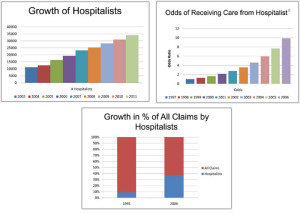Tag: coordinated healthcare
DPC, The Netflix of Healthcare
When is the last time you went to a Blockbuster Video store on a Friday night to peruse the shelves for a rental? Yup, almost ten years ago. The key question is why is it extinct? There are many obvious reasons- inconvenience of having to go search the shelves, finding out the movie you want is out, and the most obvious is innovative disruption by companies like Netflix and Amazon (see article from Forbes below).
The key component of the decline of Blockbuster Video/On Demand and the rise of Netflix is what network scientists refer to as the “threshold model of collective behavior.” In other words, this is how innovation takes hold and finds success in society whereas other products/concepts fail and drift away because they do not keep up and change to meet the needs of the consumers of the service. Blockbuster tried to adapt but it was too late. It dropped its late fees- which was their key to profitability- and spent approximately 400 million dollars instead. All the while Netflix was charging an affordable monthly fee, could deliver DVD’s to your door, and figured out how to stream content. And even though their library was not as extensive, their affordability and no hassle service made them what they are today.
So what in gods name does this have to do with me? Well, I think it is pretty obvious. The Direct Primary Care model is the Netflix of Medicine. You pay less than a coffee a day, or less than an average cable/cell phone bill a month, so that you can receive primary medical care the way it was and should be delivered. It is easy, accessible, transparent, dependable, and personalized. We bring care to you not vice versa. There may be a month when you stream ten different TV shows or movies (not speaking for myself of course) or there may be a month when you watch none, but Netflix is always there. DPC is the same, and more importantly, there is a personal relationship and level of trust that is built to help you stay healthy, be accessible when you’re sick and need care, and more importantly help guide you through the tangled web of the US Healthcare/Insurance system.
The current system of insurance-based primary care requires in person visits for all care in order to bill your insurance – even for matters that could be handled remotely with a quick phone call, text message, or Skype session. This same in person care requires copays/deductibles for each visit, provides a maximum of 10-15 minutes with your doctor on a good day, and is inflexible to scheduling around your personal life. Also, with more and more people on high deductible health plans cost is being shifted onto patients. How do you shop for elective, outpatient care like labs and imaging studies in a system of zero transparency? How, in a country as developed and wealthy as ours, did it take this long to apply simple, affordable innovation to the most important, yet most costly, consumer-based product we have- our health and well-being. The current model of insurance-based primary care is Blockbuster video. Where do you want to be when it goes bankrupt?
Endnote: it is well worth an hour of your time to watch this incredible lecture by David Goldhill- CEO of the Game Show Network and author of “Catastrophic Care- How the American Healthcare System Killed My Father”- that I was fortunate enough to be present at this October in Dallas. His book is also worth the read. Besides a mortgage, healthcare is the largest expenditure we have so be informed and learn.
If you want to learn more in depth details about the decline of Blockbuster, please read this great article from Forbes A Look at Why Blockbuster Failed
To Rent or To Buy: That is the Question
Depending on your age and income, and whether or not you are shopping for a car or a place to live, the answer to this question may vary. If you enjoy getting a new car every few years then leasing is clearly the way to go, but if you really like your car then buying would be the better choice. You will likely take better care of the car because you actually own it and have zero interest in having to make new car payments once it is fully paid. Same goes for renting an apartment versus buying a home. When you rent you are just simply handing over money to a landlord to live there. There are benefits to it such as maintenance and landscaping being covered, and if you only plan on being there a short time then renting is a great idea. However, if you are looking to have a long term or permanent place to live then buying is the way to go. You are investing in the roof over your head, your yard, and the upkeep of your property. In the long run it is a much better investment.
See chart from Trulia.com here for a visualization of how buying saves in the long run:
So I ask this question: why would anyone not want to do this for their healthcare, especially primary care which is the heart of medical care? This is nothing against the many great physicians that are employed and contracted with 3rd party payors, but when your primary care physician is being paid by a third party you are technically renting/leasing them. Maybe they will drop or be dropped by that third party? Maybe they will burn out and fade away which is happening all across the country? Maybe you will get lucky and just like the old days they will stay in one place and be contracted with your third party payor for years to come? Yes they took an oath to care for you which they do to the utmost of their abilities, but technically, given that they are being paid by their employer through your insurer they aren’t technically working for you
So what if you could own the relationship with your primary care physician and have them work only for you rather than leasing it? What if you- the patient/consumer- were the only party determining the worth and value of your doctor and the care that he/she provides instead of a third party that knows zilch about you as a person? What if you could have a mutually beneficial relationship with your personal physician based on respect and trust that exists in sickness and health? And what if you could have all of this investment for less than a coffee a day? After all isn’t your health, peace of mind, and wallet worth the investment? If the answers are yes then Direct Primary Care is here and here to stay. Lets take primary care and medicine back one doctor and patient at a time. You can rent DPC for a year and if you really like it- just like Chevy Chases’ rubber gloves in Fletch- it comes with an option to buy 🙂
DPC and Hospitalists
How does DPC help patients in the hospital? You can ask my patient quoted below or ask the Hospitalist who took care of him, but I would also like to comment on this.
There are many benefits to Hospital-based doctors (aka Hospitalists)- they are intelligent, well trained doctors and NP/PA’s and they provide 24/7 coverage if something goes wrong when you are admitted. We as primary care doctors used to practice hospital medicine as well as outpatient/office medicine, but for many reasons which is beyond the scope of this blog post, most if not all primary care doctors solely see patients in the office setting now. And there are many negatives to this which most patients who have been admitted to the hospital at some point can attest to:
- As good and caring as these doctors and NP/PAs are, they don’t know the patient like we do.
- Hospitalists often have a minimum of 10-12 patients on their census at a time some of whom may be very ill. That is a lot to manage.
- As a result of #2 and the amount of documentation and computerized order entry that goes along with it, hospitalists have very little time to call and/or email the Primary Care Physician with updates on their patients.
- This contributes to more fragmentation of care and increased costs to the system as a whole.
- Lastly, which is the worst in my opinion, is scared and confused patients.
So what does DPC do to help this? :
- We can actually come visit our patients periodically to check in and see how the hospital stay is going. The patient- like the one quoted below- gets to see their own doctor and be reassured that we are “in the loop.”
- We have more time to communicate with the Hospitalists regarding our patients histories, medication lists, social situations etc. This allows us to work in a collaborative way to ensure the patient gets the best care possible.
- I believe Hospitalists would appreciate this involvement rather than look at as us “stepping on toes.” We can provide information that the patient may not be capable of communicating or that they may not think is vital to their hospitalization.
- The end result is what healthcare should be about- BETTER OVERALL PATIENT CARE.
So here is my patients quote/review: “If U haven’t yet signed up with Gold Direct Medical Services, U R surely walking in the wrong direction! I recently had a several day hospitalization and was actually visited by Dr. Jeff Gold, and was also privy to a conference between him and the hospital doctor, to say nothing of the several daily direct calls to me in my hospital room from him. WHEN WAS THE LAST TIME YOUR DOCTOR VISITED U IN THE HOSPITAL?”
Some date on hospital medicine:




